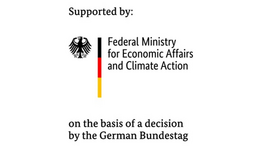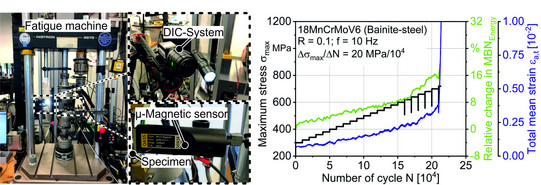Quantitative evaluation and efficient characterization of intrinsic and extrinsic influences on cyclic properties of high-strength steels
Quantitative evaluation and efficient characterization of intrinsic and extrinsic influences on cyclic properties of high-strength steels
The evaluation of fatigue life at constant load amplitudes requires considerable effort to conclude the S-N curve. To reduce the effort, instead of performing single-stage fatigue tests at different stress levels, a short-term test methodology based on an instrumented multi-stage test was developed and established as an experimental method for a time- and cost-efficient characterization of cyclic material properties, especially for high-strength steels. In addition, by using micromagnetic measurement methods during multi-stage fatigue tests, the measured MBNEnergy was correlated with the stress-strain trend and fracture behavior. The objective was to identify the critical load horizon representing the transition from short-crack initiation to long-crack propagation. The three high-strength steels 18MnCrMoV6 (Bainite steel), 38MnVS6 and 46MnVS5 (ferrite-pearlite steels) were in focus. The micro-magnetic measurement methods were adapted to the fatigue tests to allow the MBNEnergy being recorded during the entire test period. A strong correlation was observed between the MBNEnergy and the change in strain (analyzed by means of digital image correlation (DIC)) with respect to strain hardening and softening and crack propagation. The strain behavior of bainite steel differed from the strain behavior of the ferrite-pearlite steels, and the measured MBNEnergy also varied. It was indicated that each material possesses a specific initial Barkhausen noise energy that can be increased or decreased (according to material and composition) with increased stress and following elastic-plastic strain during fatigue tests. Furthermore, it was observed that each material achieves a specific MBNEnergy niveau before failure. Therefore, the trend of the exported MBNEnergy can be considered a characteristic parameter for estimating the remaining life of different materials (ferromagnetic) under cyclic loads. Additionally, mostly increases in dynamic strength were observed by decreasing the temperature (T = -10 °C and -30 °C) as well as inducing pre-strains (ε = 2 % and 0.5-Ag) in specimens before fatigue tests.
The work in this project also aimed at further developing the concept of microstructure-sensitive fatigue modeling for high-strength steels and their underlying microstructures. Microstructure-sensitive fatigue modeling was used to reveal new material design possibilities for steels subjected to high cyclic loads. Considering this issue, the concept is based on the micromechanical calculation of fatigue indicators and their correlation with cyclic properties based on analytical crack growth laws. The simulations were carried out on representative volume elements (RVE) in which the material microstructure is geometrically recorded. From these measurements, quantitative information regarding the phase fraction, grain size, shape, orientation and distribution of inclusions could be obtained. This information is used as input data for the generation of statistically representative microstructure models. The mechanical material responses under cyclic loading were described in the RVE simulations using a crystal plasticity model to describe the strain hardening that depends on the crystallographic orientation. A multiscale simulation strategy (nanoindentation tests, uniaxial tensile tests) was used to calibrate the crystal plasticity (CP) parameters of the ferrite and bainite phases and the isotropic strain hardening parameters of the pearlite phase. In the last step, the strain-controlled fatigue tests with a low number of load cycles were used to determine the kinematic strain hardening parameters of the material. The evolution of the fatigue indicator parameter under cyclic deformation was extracted from different RVE models. The dispersion of the fatigue indicator parameter at the same loading amplitude was described by an extreme value distribution function. Based on the collected fatigue indicator parameters from several statistically equivalent RVE models under different loading amplitudes, the cycles for crack initiation and failure could be determined using analytical equations. By modifying the configurations of the microstructure models and changing the corresponding constitutive parameters, the influence of intrinsic and extrinsic factors, i.e. temperature and pre-strain, on the fatigue properties could be quantitatively evaluated.
The use of a portable device for a local measurement of MBNEnergy in critical areas of components may enable a rapid estimation of the remaining fatigue life for SMEs. In addition, the use of multistage load increase tests as an alternative for single-stage fatigue tests for S-N curves can provide SMEs a time- and cost-efficient characterization of cyclic material properties. Microstructure-sensitive fatigue modeling approaches offer SMEs new opportunities for material design to consider the effects of both intrinsic and extrinsic factors on fatigue properties.
The research project IGF 20559 N/ P 1361 “Quantitative evaluation and efficient characterization of intrinsic and extrinsic influences on cyclic properties of high-strength steels” from the Research Association for steel Application (FOSTA), Düsseldorf, was supported by the Federal Ministry of Economic Affairs and Climate Action through the German Federation of Industrial Research Associations (AiF) as part of the programme for promoting industrial cooperative research (IGF) on the basis of a decision by the German Bundestag.
The final report will shortly be available from FOSTA.












